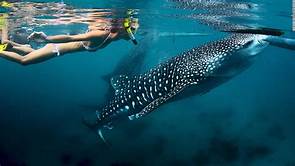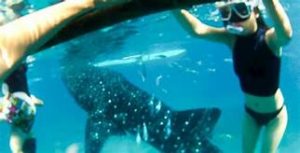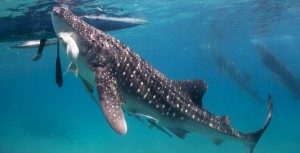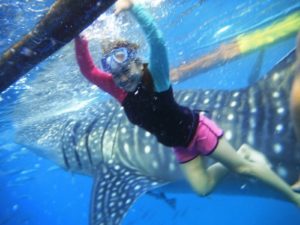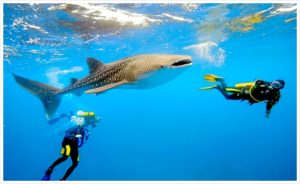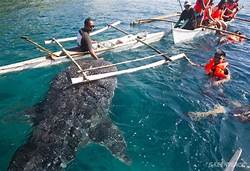Come to Dauin and Book a Trip to nearby Oslob to swim with the Whale Sharks!
Watching of whale sharks in Oslob Cebu is 99% guaranteed. Whale sharks can be seen in a small barangay Tan-awan, which is 10 km away from the center town of Oslob. Whale shark watching in Cebu started last September 2011 and it became popular all over the world when the news hit in the internet last November 2011. By December 2011, local fishermen’s interact with the whale sharks by feeding them that result to flocking of tourist to the beach of Tan-awan. Large numbers of tourists began arriving in Oslob not just to see the whale sharks being fed but also to snorkel or dive with them.
Get fascinated to watch friendly creatures of the sea as you enjoy watching and swimming with the friendly whale sharks in Oslob Cebu! Come and enjoy the adventure of lifetime experience.
Whale Shark 101: Fact-Filled Crash Course On Whale Sharks
The whale shark is one of the world’s gentlest giants. Slow swimming filter-feeders, Rhincodon typus currently holds the record for the largest fish species in the entire world. Whale sharks can reach incredible lengths of up to 40 feet, and can weigh up 20 metric tons. While intimidating in size, a whale shark’s diet consists primarily of plankton. Unlike most of their feared cousins, whale sharks use a method called filter-feeding to catch their prey. They swim with their mouths wide open (almost five feet!) in order to catch large amounts of their tiny prey. The whale shark is only one of three species of shark that filter-feed. The whale shark sports a flattened head with a blunt snout and massive mouth. They are easily identified by their incredulous size, and by their coloration. The back and sides of a whale shark are grey or brown, with a white belly. However, they are known for the white spots and pale vertical and horizontal stripes along their back. These marine behemoths live in tropical and warm temperate seas. They generally swim the open oceans alone, though they tend to gather in areas that are abundant with plankton or other prey. This makes them a prime tourist attraction, as they are often gentle enough to swim beside quite safely. Areas such as Oslob, Cebu are extremely popular for the high density of whale sharks that swim by their shores. This, however, has recently proven detrimental to the species. The amount of attention and contact that the whale shark has been receiving has ruined migratory patterns and greatly increased the density of whale sharks in a very localized area. Given a stable feeding source by those would seek […]
How to Get to Oslob for Whale Shark Watching
You have probably heard about it, but in case you haven’t – you can watch, snorkel, or dive with whale sharks in Oslob, Cebu! Ten (10) kilometres away from the center town of Oslob in Cebu, is the small barangay of Tan-awan. There, whale shark watching is a hit among many tourists. Both local and international travellers visit the town to get a closer look at these gentle giants. If like them, you also want to see the whale sharks for yourself while enjoying a great swim in the clear waters; then you better pay them a visit. But first, a quick rundown on how it all began. […]
Whale Shark Watching Tours Operates as Normal
As what you’ve seen or heard in media you could see how the Super Typhoon Haiyan (Yolanda) devastated some parts of the Philippines especially in the Visayas region where Cebu located. Oslob is in the southern part of Cebu and we were not heavily affected unlike northern Cebu that was devastated by super typhoon Yolanda last Friday, November 8. So you have nothing to worry about in traveling to Oslob for whale shark watching tours. Roads are passable and whale shark sightings is 100% guaranteed despite of the calamities. Keep coming to the beautiful island of Philippines to spend your holidays.
Secrets of Whale Shark Migration Revealed
The world’s biggest fish are hungry migrators on a mission, according to a tracking study that mapped whale sharks’ long journeys around the Gulf of Mexico and Caribbean to a favorite feeding hot spot off the Yucatan Peninsula. And one whale shark’s incredible 5,000-mile (7,200-kilometer) swim could even help solve the long-standing mystery of where whale sharks give birth—an event no scientist has ever seen. The largest-ever study of whale shark migrations, nine years in the making, shows that the hundreds of school bus-sized animals that feed in a plankton-saturated stretch off the Mexican coast come from far and wide. The gentle giants—which can reach up to 40 feet (12 meters) or longer in length, and weigh an average of 5 tons—use mouth filters to feed on the tiny plankton and small fish or eggs. Read more in National Geographic




